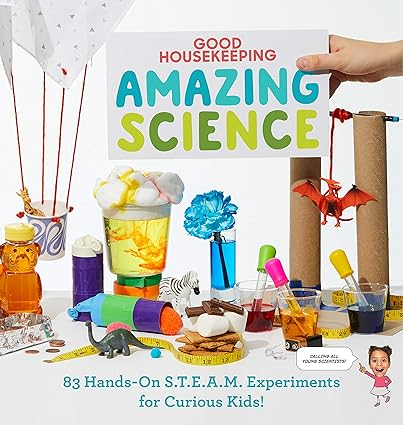An Interview with Rachel Rothman STEAM Topics for Kids
Interview with Rachel Rothman, Chief Technologist and Executive Technical Director at the Good Housekeeping Institute
 Let’s talk STEAM topics!
Let’s talk STEAM topics!
“STEAM” stands for science, technology, engineering, arts and math. This term can refer to the individual subjects of study or one or more of them working together. STEAM also refers to a way of being in
volved in learning. This includes problem solving, exploring, listening, touching and asking lots, (and lots!) of questions.
The icicles that form on the roof on a winter day is science at work. The ice cream scoop that falls off your waffle cone and starts to melt on a hot sidewalk is another example. Even that banging noise you hear outside from tree branches can be observed in a scientific way.
There are STEAM ideas and topics all around us.
Discussion, exploration and interesting hands-on discovery can begin in preschool and can help boost student learning through the following elementary, middle and high school years.
We can always be ready to look, listen and learn!
Kids Discover got a chance to talk with technology expert and author Rachel Rothman about finding ways to learn and work with STEAM topics.
How did you become interested in STEAM?
Learning how things worked was always interesting to me. I always loved and excelled at math and science classes, so as I got older and applied to college, engineering intrigued and suited me well.
How can kids find practical applications of STEAM in everyday life?
Everything involves STEAM! Science in and of itself is pursuing and applying knowledge and understanding of the world using systemaic methodology rooted in evidence. One definition of technology is practically applying knowledge to achieve goals.
Engineering is applying science and math to solve problems. We are surrounded by and interacting with science, technology, engineering and mathematics in just about everything we do, whether we mean to or not. Just reading through the definition of what these fields of study are, showcase how just by thinking, challenging, questioning, you are incorporating STEAM into your everyday life!
How can kids be challenged to problem solve and tinker?
As a parent, I always invite my children to be “investigators” and “problem-solvers.” When they were really young, I would help guide them, but now they feel empowered by this “detective job.”
Problems are a part of life, and as a parent my first step is always to validate whatever emotion they are having. My daughter finds it very helpful to remind her of times she previously figured out problems (it could be something as simple as her rebuilding after her brother knocked down her tower, or how even just the year before she couldn’t swing on her own).
Much of my children’s emotional regulation and problem-solving skills has been learned through creative play. It allows them to learn in a safe environment where they don’t feel as pressured.
When obstacles come their way, I don’t immediately swoop in and solve it, but allow them to experience the difficulty within reason and help them navigate potential solutions.
What are toy recommendations for STEAM skills?
There are many toys that will help support STEAM skills for children (yay!), but finding one that is age and developmentally appropriate is key. There are a few go-to brands that we love for helping reinforce STEAM skills, including ThinkFun, Roylco, Learning Resources and Lego.
Here is a recent round-up of great STEAM toys for varied ages/stages:
https://www.goodhousekeeping.com/childrens-products/g5162/best-stem-toys/
What are tips to explore STEAM outside?
One of our favorite ways as a family to explore STEAM outside is to go on nature walks. If, as a parent or caregiver this may feel daunting, there are wonderful products you can get.
(https://www.amazon.com/Melissa-Doug-Explore-Outdoor-Scavenger/dp/B09D41WW44)
You can easily get started on observing, collecting and documenting! Just by being outside, whether in the water and exploring aquatic life, or in the garden and learning about plant growth and sustainability, kids can start to get involved in STEAM principles.
Each morning we also make one of our children the meteorololgist, observing and recording the local weather conditions outside of our home. What’s the temp? Is there rainfall? Is it windy? Many children learn well through the unique opportunities afforded by hands-on experiences!
How can we recognize “outside-the-box” places where STEAM can be found?
Many people will be surprised by the abundance of local STEAM activities in their neighborhood.
When I moved, even I was certainly awestruck by the number of local businesses that were supporting the STEAM pipeline. For instance, many libraries now offer great programming around STEAM, our local library offers 3D printing workshops, coding classes and science demonstrations. We have local historical sites with STEAM-related activities and offerings, cultural festivals showcasing innovative tech and STEAM activities, and community spaces filled with wonderful workshops and resources for hands-on STEAM learning.
How can kids understand STEAM beyond screens and machines?
While several have been noted above, STEAM abounds us! You can find STEAM in nature explorations, hands-on experiments, cooking and backing (chemistry! math!), gardening, games and puzzles, crafting and more.
https://www.goodhousekeeping.com/childrens-products/toy-
reviews/g44960293/best-building-toys-for-kids/)
Just applying the lens of observing, researching, hypothesizing, testing, analyzing and reporting helps individuals observe and interact more thoughtfully with their environments.
How can kids recognize people who are involved in STEAM?
I always recommend for kids to attend STEAM events (science fairs, robotic or other engineering competitions, etc.) as enthusiasts and professionals are often in attendance and/or judging.
Similarly, by joining STEAM clubs and reading books, you can learn about different fields of STEAM professional work. I actively participate in a handful of online communities as well that help support showcasing various STEAM roles like Engineering Girl. For those interested in further deep-dives, workshops and camps may be a great opportunity for enriched learning.
What subjects interested you in school?
I remember loving math from a very young age, as young as I can remember. My father turned me into a human calculator, where he would ask me math problems, and I took real pride in having that strength. My aptitude for subjects that were quantifiable led to a later interest in physics-based sciences and the ultimate enrollment in an engineering course of study.
I initially planned to study civil engineering, but the program dissolved by the time I began college, so I eventually declared mechanical engineering as my major instead. It was the broadest discipline with a physics base and I’d really enjoyed facets of the degree that I’d experienced during my coursework freshman year. I also knew people ahead of me who were doing really cool things with their mechanical engineering training so I realized it would give me the background to explore different career options.
What is a piece of advice or words of encouragement you got from a teacher or mentor?
That it’s okay to reach out for advice and mentorship. I was afraid I would be bothering someone who was more important than I was, but in truth I’ve learned along the way that creating a supportive network is beneficial for all parties involved. Network like crazy!
Can you share the title of your favorite book as a kid?
Where the Sidewalk Ends, by Shel Silverstein
What are you reading now?
I’m reading Baby, Unplugged by Sophie Brickman
